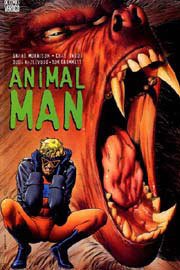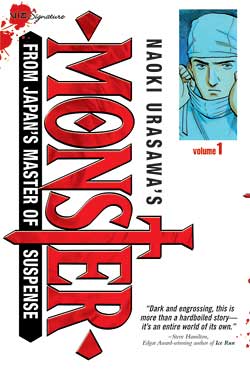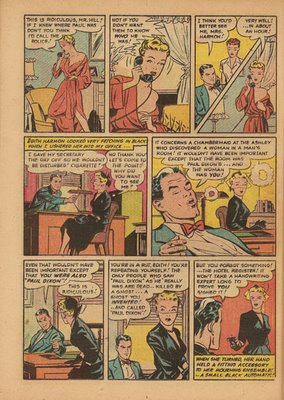Recent Comics Reading
by T. Hodler
Friday, August 4, 2006
Read Comment (1)
Sorry about the delay in posting — but for whatever it’s worth in return, the next issue of Comics Comics is shaping up very nicely.
Anyway, here are some of the things I’ve been reading recently:
 Sloth, by Gilbert Hernandez
Sloth, by Gilbert Hernandez
I liked this quite a bit, and it’s definitely one of his better efforts for a mainstream publisher. Not exactly Hernandez Lite, this is both far less weird than his Love & Rockets work and far more weird than anything else I’ve read from Vertigo. The story, which involves characters changing places, and revolving protagonists, is somewhat reminiscent of recent David Lynch films, like Lost Highway and Mulholland Drive. It’s definitely worthwhile, but seems like minor Hernandez to me; it also cries out for a second reading before I can really make sense of it and say for sure. Which I don’t quite feel up to right away, so make of that what you will.
 Forbidden Worlds #132
Forbidden Worlds #132
This is the first non-Herbie ACG comic I’ve read, and it’s a lot of fun. If you like mindless fantasy comics, this is definitely worth checking out. This issue comes late in the game for ACG, after the company gave up its long resistance to the superhero craze and introduced Magicman. It’s pretty apparent that Richard E. Hughes (who apparently wrote all or most of the company’s stories using weird pseudonyms like Zev Zimmer, Greg Olivetti, and Ace Aquila, among many others) didn’t care to put too much thought into his hero, and basically allows Magicman to be capable of anything. In this issue, Magicman has to stop a gigantic, telepathic beast called Ancient Ape, and in the process he uses his “magic” to fly, throw rocks, start tornadoes, appear to transform into a giant snake, and at one point, he even summons the Frankenstein monster and Dracula to fight on his behalf! Pretty hilarious stuff. The other two stories in the issue are basically drawn-out one-punchline gags, that are so stupid and unfunny they come out the other side and become funny again. The effect is somewhat similar to what Rick Altergott achieves in some of his Doofus strips, though the art is not in any way comparable. Anyway, I’m definitely going to be on the lookout for more of these.
 Animal Man
Animal Man
I’m not exactly a Grant Morrison detractor, but I do find the near-constant and universal praise for him a little hard to take. All-Star Superman is admittedly fun, but it’s also pretty slight and I think its successes owe more than a little to the work of artist Frank Quitely. Seven Soldiers has some interesting ideas and concepts, but basically that seems to be almost all it has. It sometimes seems to me that Morrison just throws a bunch of concepts together and doesn’t bother trying to make any kind of coherent whole out of them, or think through all of the ramifications. That leaves a lot of work for his supporters, but they don’t seem to mind making the effort, so I guess it’s all okay in the end. But it would all go down a lot smoother without all of the near-messianic proclamations made by and for him, and I think his current hero status says more about the general state of “mainstream” comics than it does about the actual strength of his work. (Not that he’s bad, mind you, but that almost everything else is.)
Or anyway, that’s how I’ve felt so far, but I’ve never read most of the early comics he made his name with (Animal Man, Doom Patrol, and the like), and I thought I should give it a chance. This first collection of Animal Man is fairly enjoyable, and I’ll keep reading to see what he makes out of it. This collection includes “The Coyote Gospel”, which apparently is the most well-regarded early story in this series. But while the conceit of having a Wile E. Coyote clone represent a Christ-like martyr suffering for the sins of the world is kind of appealing, it doesn’t really make sense when you think about it for very long. The original Wile E. Coyote wasn’t very Christ-like in his motives or feelings, and if anything, like most comic figures, he represents base humanity itself, not the son of God. Not that this couldn’t be made to work anyway, but it doesn’t seem as if Morrison bothered to go through all the trouble of connecting all the dots, and just thought, hey, wouldn’t it be cool to have Wile E. Coyote in a crucifixion pose? (The recent Superman movie displayed similar problems.)
But whatever — this is still early in the series, maybe it’ll all make sense in the end, and I’ll try the next volume with an open mind.
 Short Order Comix #2
Short Order Comix #2
I must have heard of this before (I’ve certainly read some of the stories here), but I blanked on it when I saw this in a store recently. (Apparently Last Gasp is distributing it; maybe they found some old copies in a warehouse?) This is the second and final issue of a pre-Arcade anthology edited by Bill Griffith and Art Spiegelman, featuring cartoonists like Joe Schenkman, Diane Noomin, Jay Kinney, and Rory Hayes. Some of this stuff is kind of dated, but Willy Murphy‘s parodies of newspaper strips hold up nicely, Hayes’s strip is reliably bizarre, and Griffith comes up with a good platform-shoe-with-goldfish-in-the-heel joke a good fourteen years before I’m Gonna Git You Sucka.
The real standout story here, though, is Spiegelman’s “Ace Hole, Midget Detective”. It’s occasionally a little pretentious, but moments here are brilliant, like a panel juxtaposing a quote from the old Comics Code (“6) In every instance good shall triumph over evil… 7) Scenes of excessive violence shall be prohibited…”) with a reproduction of Picasso’s Guernica. It also shows a real joy in the act of creation and innovation that has sometimes seemed lacking in Spiegelman’s more recent work. In any case, this story alone makes the issue worth seeking out.











